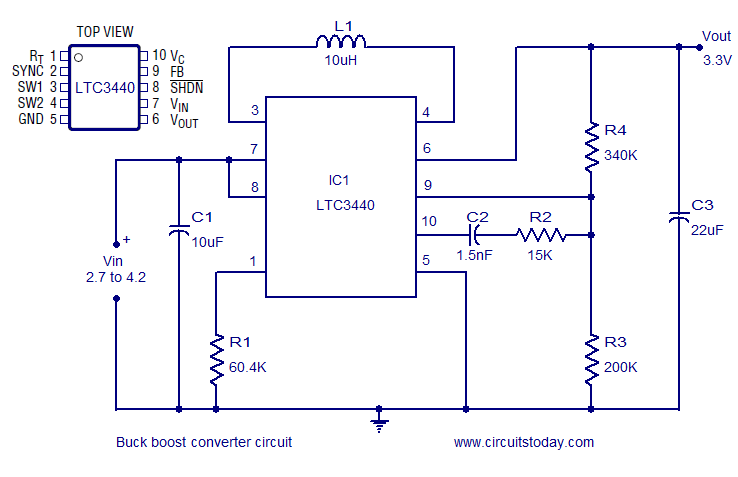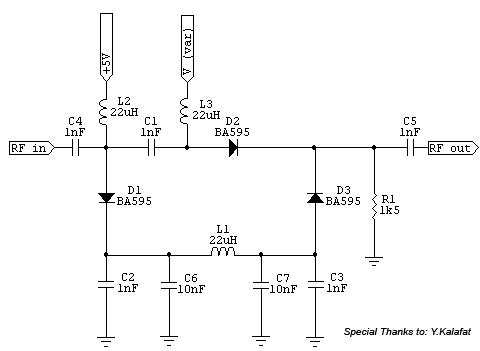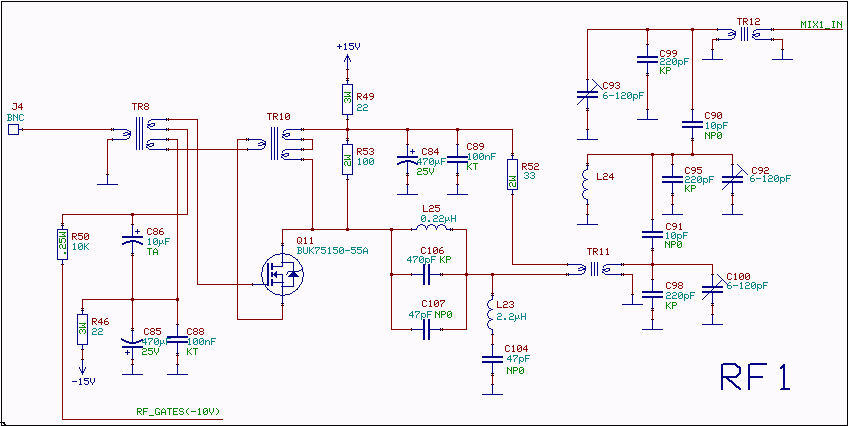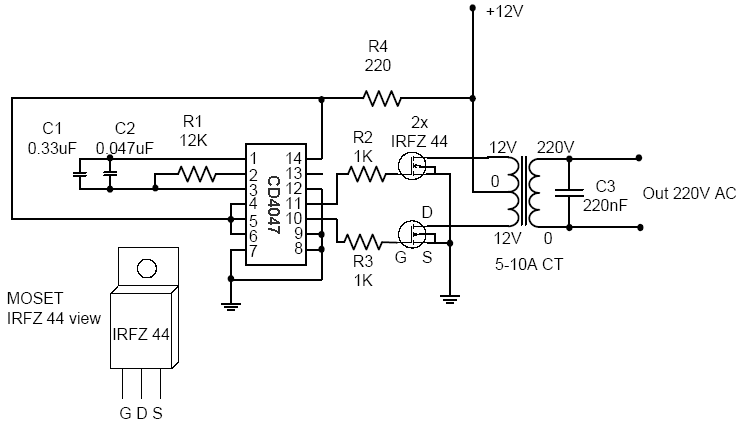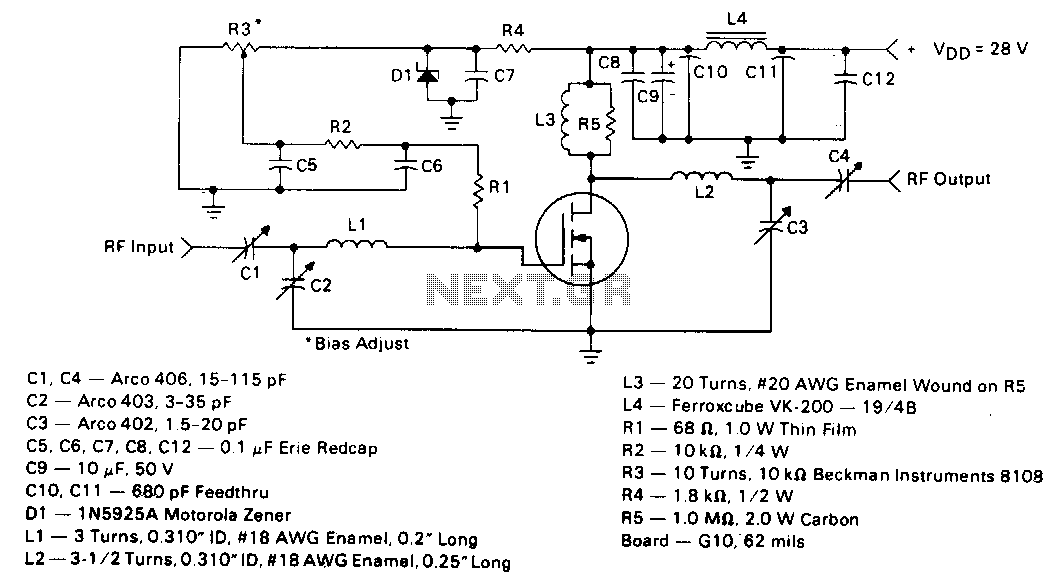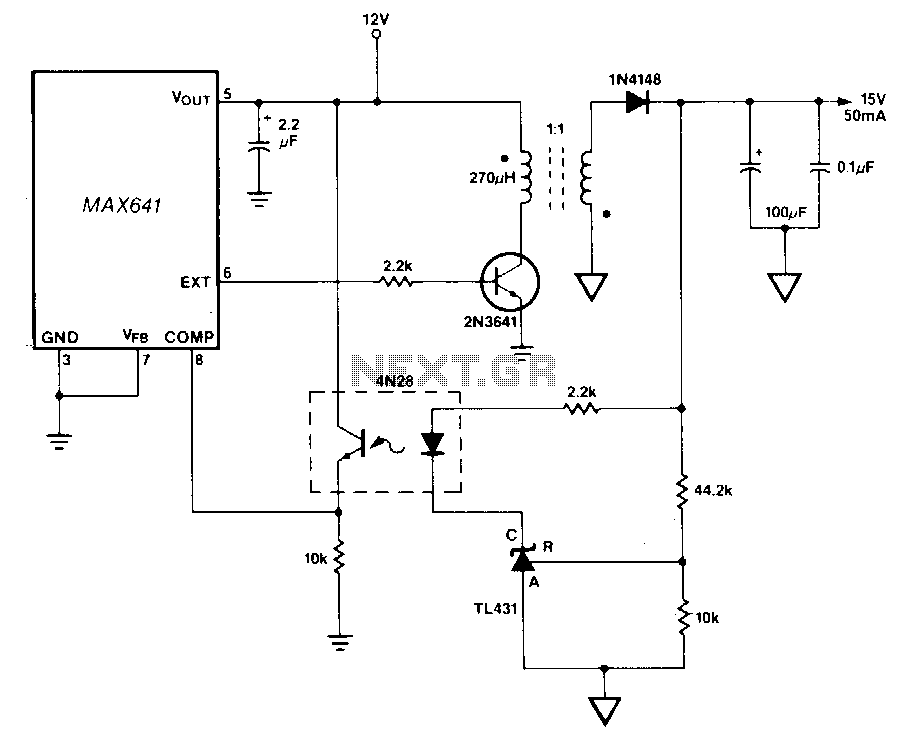
A receiving converter for 2320 MHz
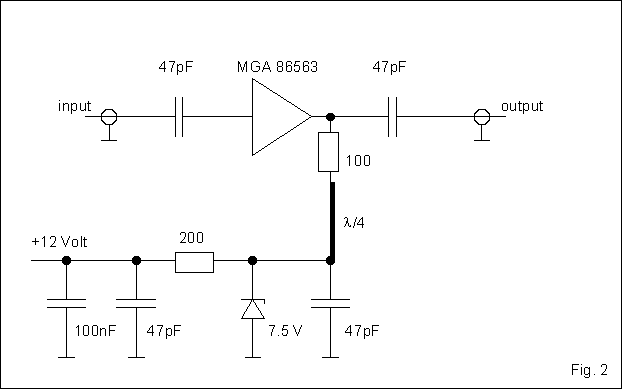
The preamplifier is straightforward, utilizing a low-noise integrated circuit manufactured by Hewlett Packard, specifically the MGA86563. This device features a noise figure of approximately 2 dB and operates within a frequency range of 0.5 GHz to at least 6 GHz. At a frequency of 2.3 GHz, it provides a gain of about 20-22 dB. The input and output ports are internally matched to 50 ohms. To implement this circuit, a capacitor must be placed before and after the device, along with a supply voltage of 5-7 volts at the output port. A quarter-wave stripline is used for the supply voltage. A 100-ohm resistor is included to "de-Q" the circuit, preventing oscillations. This resistor causes a voltage drop that necessitates a slightly higher supply voltage of 7.5 volts. The harmonic mixer comprises two Schottky diodes (BA481), which short-circuit the signal twice during each cycle of the local oscillator (LO) signal (once per half-wave). A bandpass filter is positioned at the input to suppress image frequencies. An ERA 3 monolithic amplifier from Mini Circuits amplifies the signal by an additional 20 dB. While this amplifier is not essential for optimal sensitivity, it enhances the signal strength at 144 MHz, allowing the converter to be placed at the antenna and enabling the use of inexpensive coaxial cable for the intermediate frequency (IF). It is advised against using a 144 MHz amplifier at the output, as strong 144 MHz signals from nearby sources could interfere with the 13 cm signal. An LC transformation circuit at the output ensures that the mixer is not overloaded by the 50-ohm impedance of the IF receiver. The circuit diagram for the 1088 MHz local oscillator is not provided, as the design is not recommended. The local oscillator is constructed using a 1088 MHz voltage-controlled oscillator (VCO) phase-locked with an MC74HC4046 phase comparator and a U893 prescaler. A 17 MHz reference oscillator was required, but a 17 MHz crystal was unavailable, leading to the use of a 12 MHz crystal oscillator mixed with a NE612 and a 5 MHz crystal to generate the required 17 MHz signal for the phase comparator. Although the circuit functions adequately, the sideband noise from the oscillator is suboptimal compared to a multiplied crystal signal. Despite employing a high cutoff frequency for the phase-locked loop (PLL) low-pass filter, some noise persists. It is recommended to utilize existing circuits designed for 23 cm converters, which generate a 1152 MHz LO signal by multiplying a 96 MHz crystal oscillator by 12. A 90.667 MHz crystal can yield the desired 1088 MHz output. An output power of 5 mW is ideal, although 2 mW is also effective. The design does not require excessive harmonics in the signal, as the two diodes in the mixer will handle this. The converter has been tested successfully, showing sensitivity comparable to commercially built converters. The local oscillator sideband noise is not noticeable when using single-sideband (SSB) modulation. However, when receiving FM signals from nearby stations, some audio noise is present, even with strong signals.
The preamplifier circuit employs the MGA86563 low-noise amplifier, which is designed for high-frequency applications, ensuring minimal noise contribution while maintaining strong signal amplification. The internal matching of the input and output ports to 50 ohms simplifies integration with standard RF components. The inclusion of capacitors before and after the amplifier is crucial for DC blocking and ensuring that the amplifier operates correctly within its specified voltage range.
The use of a 100-ohm resistor serves a dual purpose: it stabilizes the circuit by reducing the quality factor (Q) and prevents unwanted oscillations that could compromise performance. The design's reliance on a quarter-wave stripline for power supply routing minimizes potential interference and loss, enhancing overall circuit reliability.
The harmonic mixer, constructed with Schottky diodes, efficiently converts the RF signal by mixing it with the local oscillator frequency, while the bandpass filter effectively suppresses unwanted image frequencies, ensuring that only the desired signal is processed. The ERA 3 amplifier further boosts the signal, which is particularly beneficial in applications where signal strength is critical, such as in satellite communications.
The choice of a phase-locked loop for the local oscillator provides frequency stability, although the design's limitations in achieving optimal sideband noise performance suggest a need for careful selection of oscillator components. The recommendation to utilize established designs for local oscillator generation reflects best practices in RF circuit design, ensuring reliable operation in various environments.
In summary, this circuit design illustrates a well-thought-out approach to RF amplification and mixing, balancing performance with component availability and cost considerations. The successful operation of the converter at 13 cm demonstrates its effectiveness in practical applications, making it a viable option for amateur radio enthusiasts and other users requiring reliable RF signal processing.The preamplifier is very simple. I used a Low Noise integrated circuit manufactured by Hewlett Packard. The device name is MGA86563. It has a Noise Figure of about 2dB and can be used from 0. 5 GHz to at least 6 GHz. The gain is about 20-22dB at 2. 3 GHz. The input and output ports are internally matched to 50 Ohms. All you have to do is to put a ca pacitor in front of the device and behind it and provide the necessary supply voltage of 5-7 Volts at the output port. I used a quarterwave stripline for the supply voltage. The 100 Ohms resistor is used to "de-Q" the circuit in order to avoid oscillations. This resistor causes a voltage drop that must be equalized by a somewhat higher supply voltage of 7. 5 Volts. (Fig. 2) The harmonic mixer is not much more than two Schottky Diodes BA481. They short circuit the signal twice at every periode of the LO signal (at every half-wave). At the input there is a bandpass filter to suppress the image frequency. A monolitic amplifier ERA 3 from Mini Circuits (New York) amplifies the signal for another 20dB. This is not necessary in order to have an optimal sensitivity (the preamp would be sufficient without another amplifier) but it helps to have a strong signal at 144 MHz.
This allows you to put the converter at the antenna and use a cheap coax cable for the IF. A 144 MHz amplifier at the output is not advisible because strong 144MHz-signals from the neighborhood could get into the amplifier and then cause interference to your 13cm signal. The LC-transformation-circuit at the output makes sure that the mixer is not overloaded by the 50 Ohms of the IF receiver.
(Fig. 3) I will not give the circuit diagram for the 1088 MHz local oscillator. It is really not adviceable the way I did it (now I know!). I built a 1088 MHz VCO and phase-locked it using a MC74HC4046 phase comparator and a U893 prescaler. As a reverence oscillator I needed a 17 MHz oscillator but I could not get a 17 MHz crystal. So I used a 12 MHz crystal oscillator and mixed the signal using a NE612 with an adapted 5 MHz crystal. After filtering the 17 MHz-signal I was able to feed it into the 74HC4046 phase comparator. The circuit works good so far, but the sideband noise of the oscillator signal is not half as good as that of a multiplied crystal signal.
Despite the fact that I used a high cut-off frequency for the PLL low pass filter the oscillator signal is still a little bit noisy. So I suggest that you use one of the many circuits that are available for 23cm converters. They produce a LO signal of 1152 MHz by multiplying a 96 MHz crystal oscillator by 12. If you use a 90. 667 MHz crystal you get 1088 MHz. An output of 5mW will be very fine but 2mW will also work well. (You don`t have to have a lot of harmonics in your signal because there are two diodes in the mixer. I would work well even if your LO signal would be 100% clean. ) The converter works just fine here at my station. We have compared the sensitivity to that of comercially built converters and were not able to detect any difference.
If I use SSB I do not notice the LO sideband noise. (That is why several amateurs use this kind of LO for satellite reception at 13cm. ) When listening to FM signals from my friends in the neighborhood the audio signal is always a little bit noisy even if the signals are strong enough. 🔗 External reference
The preamplifier circuit employs the MGA86563 low-noise amplifier, which is designed for high-frequency applications, ensuring minimal noise contribution while maintaining strong signal amplification. The internal matching of the input and output ports to 50 ohms simplifies integration with standard RF components. The inclusion of capacitors before and after the amplifier is crucial for DC blocking and ensuring that the amplifier operates correctly within its specified voltage range.
The use of a 100-ohm resistor serves a dual purpose: it stabilizes the circuit by reducing the quality factor (Q) and prevents unwanted oscillations that could compromise performance. The design's reliance on a quarter-wave stripline for power supply routing minimizes potential interference and loss, enhancing overall circuit reliability.
The harmonic mixer, constructed with Schottky diodes, efficiently converts the RF signal by mixing it with the local oscillator frequency, while the bandpass filter effectively suppresses unwanted image frequencies, ensuring that only the desired signal is processed. The ERA 3 amplifier further boosts the signal, which is particularly beneficial in applications where signal strength is critical, such as in satellite communications.
The choice of a phase-locked loop for the local oscillator provides frequency stability, although the design's limitations in achieving optimal sideband noise performance suggest a need for careful selection of oscillator components. The recommendation to utilize established designs for local oscillator generation reflects best practices in RF circuit design, ensuring reliable operation in various environments.
In summary, this circuit design illustrates a well-thought-out approach to RF amplification and mixing, balancing performance with component availability and cost considerations. The successful operation of the converter at 13 cm demonstrates its effectiveness in practical applications, making it a viable option for amateur radio enthusiasts and other users requiring reliable RF signal processing.The preamplifier is very simple. I used a Low Noise integrated circuit manufactured by Hewlett Packard. The device name is MGA86563. It has a Noise Figure of about 2dB and can be used from 0. 5 GHz to at least 6 GHz. The gain is about 20-22dB at 2. 3 GHz. The input and output ports are internally matched to 50 Ohms. All you have to do is to put a ca pacitor in front of the device and behind it and provide the necessary supply voltage of 5-7 Volts at the output port. I used a quarterwave stripline for the supply voltage. The 100 Ohms resistor is used to "de-Q" the circuit in order to avoid oscillations. This resistor causes a voltage drop that must be equalized by a somewhat higher supply voltage of 7. 5 Volts. (Fig. 2) The harmonic mixer is not much more than two Schottky Diodes BA481. They short circuit the signal twice at every periode of the LO signal (at every half-wave). At the input there is a bandpass filter to suppress the image frequency. A monolitic amplifier ERA 3 from Mini Circuits (New York) amplifies the signal for another 20dB. This is not necessary in order to have an optimal sensitivity (the preamp would be sufficient without another amplifier) but it helps to have a strong signal at 144 MHz.
This allows you to put the converter at the antenna and use a cheap coax cable for the IF. A 144 MHz amplifier at the output is not advisible because strong 144MHz-signals from the neighborhood could get into the amplifier and then cause interference to your 13cm signal. The LC-transformation-circuit at the output makes sure that the mixer is not overloaded by the 50 Ohms of the IF receiver.
(Fig. 3) I will not give the circuit diagram for the 1088 MHz local oscillator. It is really not adviceable the way I did it (now I know!). I built a 1088 MHz VCO and phase-locked it using a MC74HC4046 phase comparator and a U893 prescaler. As a reverence oscillator I needed a 17 MHz oscillator but I could not get a 17 MHz crystal. So I used a 12 MHz crystal oscillator and mixed the signal using a NE612 with an adapted 5 MHz crystal. After filtering the 17 MHz-signal I was able to feed it into the 74HC4046 phase comparator. The circuit works good so far, but the sideband noise of the oscillator signal is not half as good as that of a multiplied crystal signal.
Despite the fact that I used a high cut-off frequency for the PLL low pass filter the oscillator signal is still a little bit noisy. So I suggest that you use one of the many circuits that are available for 23cm converters. They produce a LO signal of 1152 MHz by multiplying a 96 MHz crystal oscillator by 12. If you use a 90. 667 MHz crystal you get 1088 MHz. An output of 5mW will be very fine but 2mW will also work well. (You don`t have to have a lot of harmonics in your signal because there are two diodes in the mixer. I would work well even if your LO signal would be 100% clean. ) The converter works just fine here at my station. We have compared the sensitivity to that of comercially built converters and were not able to detect any difference.
If I use SSB I do not notice the LO sideband noise. (That is why several amateurs use this kind of LO for satellite reception at 13cm. ) When listening to FM signals from my friends in the neighborhood the audio signal is always a little bit noisy even if the signals are strong enough. 🔗 External reference
